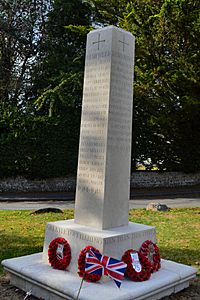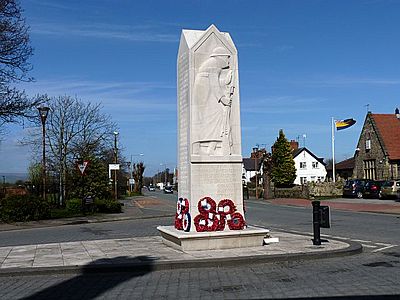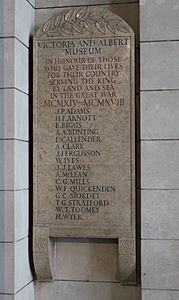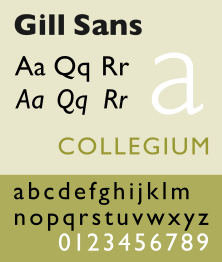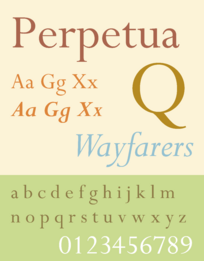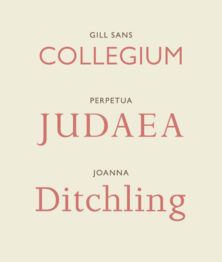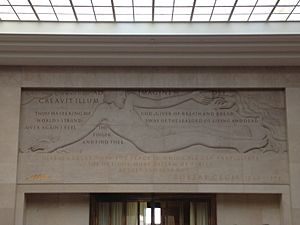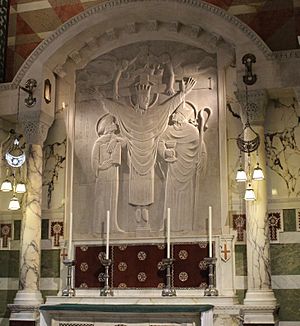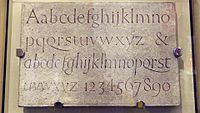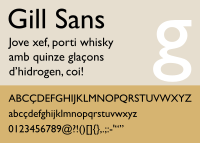Eric Gill facts for kids
Quick facts for kids
Eric Gill
ARA RDI
|
|
|---|---|

Self-portrait
|
|
| Born |
Arthur Eric Rowton Gill
22 February 1882 Brighton, Sussex, England
|
| Died | 17 November 1940 (aged 58) Middlesex, England
|
| Education |
|
| Known for | Sculpture, typography |
| Movement | Arts and Crafts movement |
Arthur Eric Rowton Gill (born February 22, 1882 – died November 17, 1940) was a famous English artist. He was a sculptor, a letter cutter, a typeface designer (someone who creates fonts), and a printmaker. Many people consider him one of the most important artist-craftsmen of the 20th century. He was especially good at designing letters and fonts.
Gill was born in Brighton and grew up in Chichester, England. He studied art and later moved to London to train as an architect. However, he soon decided he preferred working with stone and letters. He started his own business making inscriptions for buildings and gravestones. He also designed special headings for books.
As a young man, Gill was interested in social movements. He became a Roman Catholic in 1913 and stayed Catholic his whole life. He created special communities where people worked with their hands. They focused on traditional crafts instead of modern machines. These communities often had a chapel at their center.
One of his first communities was in Ditchling, Sussex. Here, Gill and his helpers made important war memorials. These included memorials in Chirk and Trumpington. They also created many religious artworks.
In 1924, Gill and his family moved to an old monastery in Wales. This quiet place helped him create some of his best art. He made sculptures like The Sleeping Christ and Mankind. He also designed famous fonts like Perpetua, Gill Sans, and Solus.
After four years, Gill moved to Speen in Buckinghamshire. In his last ten years, he became a well-known sculptor for buildings. He created large artworks for important places in London. These included the BBC headquarters and the London Underground. His huge artwork, The Creation of Man, was a gift from the British government to the League of Nations building in Geneva.
Gill wrote many books and pamphlets about religion and society. He often spoke out against factories and machines. He believed in peaceful ideas and supported left-wing causes before World War II. He continued sculpting until just weeks before he died.
Contents
Gill's Early Life and Training
Growing Up in Chichester
Eric Gill was born in 1882 in Brighton, England. He was the second of 13 children. His father, Arthur Tidman Gill, was a minister. Eric's older brother, MacDonald Gill, also became a graphic artist.
In 1897, Eric's family moved to Chichester. Eric studied at the Chichester Technical and Art School. He loved drawing and became very interested in lettering. He later said that the old stone carvings in Chichester Cathedral greatly influenced his sculptures.
Learning in London
In 1900, Gill moved to London. He began training as an architect. His job was with a company that designed churches. However, he soon felt bored with architecture.
So, he took evening classes in stonemasonry (working with stone). He also studied calligraphy (beautiful handwriting) at the Central School of Arts and Crafts. His calligraphy teacher, Edward Johnston, became a very important influence on him. Johnston created the famous font used for the London Underground.
Starting His Art Career
By 1903, Gill decided to stop his architecture training. He wanted to be a calligrapher, letter-cutter, and monumental mason. His first public stone carving was for a memorial in Chichester Cathedral.
Soon, he got more jobs. He carved inscriptions for churches and private clients. He also designed special pages for books. In 1903, he even painted lettering for W.H. Smith & Son stores in Paris. These jobs became so frequent that he left his architecture firm. After he died, people found that he had carved over 762 inscriptions.
Life in Ditchling Village
Moving to the Countryside
In 1904, Gill married Ethel Hester Moore. They later had three daughters and fostered a son. After living in London for a short time, they moved to Hammersmith. Many artists and printers lived in this area.
Gill started a business with a partner and hired staff. He also taught classes in stone carving and lettering. In 1907, Gill moved his family to a house in Ditchling, a village in Sussex. This village later became a center for artists who followed Gill's ideas.
Becoming a Sculptor
Even though he moved to Ditchling, Gill still spent time in London. He visited clients and gave lectures. He continued to focus on lettering and stone inscriptions. He also started using wood engraving for book illustrations.
In late 1909, Gill decided to become a sculptor. He preferred to carve figures directly from stone. He didn't like the usual method of making a model first.
Gill had his first sculpture exhibition in London in 1911. His work was also shown in a big art exhibition in 1912 and 1913.
Becoming a Catholic Artist
By 1912, Gill was known for his gravestone inscriptions. He also carved many figures of the Madonna. People thought he was a Catholic artist, even though he wasn't yet.
He was invited to a Catholic art exhibition in Brussels. On his way, he visited a Benedictine monastery. Seeing the monks pray and hearing their singing convinced him. In February 1913, Gill and his wife became Roman Catholics. His wife Ethel changed her name to Mary.
Important Works and Communities
Westminster Cathedral Art
After becoming Catholic, Gill and his wife moved to Ditchling Common. Here, Gill worked mostly for Catholic clients. In 1914, he received a big job: to create the 14 stations of the cross for Westminster Cathedral. This was a surprising choice because he was new to Catholicism and had only been a sculptor for three years. However, he was willing to do the work quickly and for less money.
The Stations were simple in design. Some people didn't like them at first because they looked so different from the rest of the cathedral. But later, many praised their clear design. Today, they are seen as some of Gill's best large-scale works.
The Guild of St Joseph and St Dominic
After World War I, Gill helped start a group called the Guild of St Joseph and St Dominic at Ditchling. The Guild wanted to bring back old ways of making things by hand. They believed in manual labor instead of modern machines. They thought craft work was a form of holy worship.
All members of the Guild were Catholic. They even built a chapel in the middle of their workshops. Gill designed this chapel. He also carved a wooden cross with a figure of Christ for a nearby hill.
The Guild had its own printing press, the St Dominic's Press. It printed books and pamphlets about their ideas. It also showed off Gill's engravings and woodcut illustrations.
War Memorials and Other Art
During this time, Gill designed several war memorials. These included memorials in Trumpington, Chirk, and Ditchling. He also created memorials for the British Museum and the Victoria and Albert Museum.
Many craft workers joined the Ditchling community. By the early 1920s, there were 41 people living there. Famous visitors included G. K. Chesterton.
However, Gill became unhappy with the Guild's direction. In 1924, he left the Guild. He moved his family to an empty monastery in the Black Mountains of Wales.
Creative Years in Wales
Life at Capel-y-ffin
In August 1924, the Gills moved to the old monastery at Capel-y-ffin in Wales. This isolated place was perfect for Gill. He wanted to be away from what he saw as a world that was too focused on industry.
Soon after arriving, Gill completed Deposition, a sculpture of Christ. He also made The Sleeping Christ, a stone head now in the Manchester Art Gallery. In 1926, he finished a sculpture called Tobias and Sara.
Book Illustrations and New Fonts
While in Wales, Gill started working with the Golden Cockerel Press. He became their main engraver and illustrator. He created amazing designs that blended illustrations with the text. He also designed a new font for the press.
Some of the books he illustrated are now considered classics. These include The Song of Songs (1925) and The Four Gospels (1931). Gill also wrote 38 of his own books and illustrated 28 others during this time.
Another important partnership was with Stanley Morison from the Monotype Corporation. Morison convinced Gill to use his letter-cutting skills to create fonts for machines. At Capel-y-ffin, Gill designed the fonts Perpetua (1925), Gill Sans (starting in 1927), and began work on Solus (1929). Gill Sans is still one of the most popular fonts ever created.
Mankind Sculpture
In 1927, Gill worked in a London studio to create a large sculpture called Mankind. This giant torso was praised by many. It was later bought by artist Eric Kennington. Today, it is part of the Tate collection and displayed at the Victoria and Albert Museum.
It was too hard to bring large stones to Capel-y-ffin. Gill realized that the monastery was too far away for his growing work. So, in 1928, he started looking for a new home for his family and workshops.
Later Years and Major Commissions
Moving to Pigotts
In October 1928, the Gill family moved to Pigotts in Speen, Buckinghamshire. Stables and barns were turned into studios and workshops.
After a successful exhibition in 1928, Gill became very well known. He was asked to lead a team of sculptors for the new London Underground headquarters. He carved three of eight relief sculptures for the building. These sculptures were based on the theme of The Four Winds.
Famous Artworks and Fonts
The next two years were very creative for Gill. He started his own printing press at Pigotts in 1931. For this press, he created the Joanna font. He also finished The Four Gospels, which is considered one of the best books from the Golden Cockerel Press.
Gill also began working on the sculpture Prospero and Ariel for the BBC's Broadcasting House in London.
In 1932–33, Gill created several artworks for the Midland Hotel, Morecambe. He made two seahorses for the entrance. He also created a large stone relief of Odysseus for the lounge.
International Recognition
In 1934, Gill visited Jerusalem to work at the Rockefeller Archaeological Museum. He carved a stone relief above the entrance showing Asia and Africa meeting. He also made ten stone reliefs illustrating different cultures.
Gill created seven relief panels for the People's Palace in London, which opened in 1936. In 1937, he designed the background for the first George VI postage stamp series.
In 1938, Gill was asked to create a huge artwork for the Palace of Nations building in Geneva. This was a gift from the British Government to the League of Nations.
This work, called The Creation of Man, was made of three marble reliefs in seventeen sections. It was the largest single artwork Gill ever created.
Gill received many honors for his work. In 1937, he was named a Royal Designers for Industry, which is the highest British award for designers. In 1937, he also became a member of the Royal Academy.
Final Projects and Legacy
Last Works
In 1938 and 1939, Gill designed his only complete building: the Roman Catholic Church of St Peter the Apostle at Gorleston-on-Sea. He designed the church with the altar in the center, which was a new idea for Catholic churches at the time.
Some of Gill's last sculptures were for Guildford Cathedral. He also worked on a set of panels for the stations of the cross for a church in Oxford. He finished the drawings just three weeks before he died.
Gill died of lung cancer on November 17, 1940, in Middlesex. He was buried in Speen's Baptist churchyard.
After he died, people counted his many works. He had created over 750 carved inscriptions, more than 100 stone sculptures, 1000 engravings, several font designs, and 300 printed works.
Gill's Typefaces and Inscriptions
In 1909, Eric Gill carved Alphabets and Numerals for a book. He later gave these designs to the Victoria and Albert Museum for students to use.
In 1914, Gill met Stanley Morison, a typographer. Morison asked Gill to design the Gill Sans font in 1927–30. Gill Sans was based on the simple, clear lettering used for the London Underground.
Gill Sans became one of the most popular British fonts. It was used by Penguin Books and by British Railways. In the 1990s, the BBC started using Gill Sans for its logo and TV graphics.
-
British Railways sign at Lowestoft railway station in Gill Sans
Other fonts designed by Eric Gill include:
- Golden Cockerel Press Type (1929) - designed to go well with wood engravings.
- Solus (1929)
- Aries (1932)
- Floriated Capitals (1932)
- Bunyan (1934)
- Pilgrim (a new version of Bunyan; 1953)
- Jubilee (also called Cunard; 1934)
Where to Find Gill's Work
You can find many of Eric Gill's papers and letters at the William Andrews Clark Memorial Library in California. Some of his books have been put online.
Other collections of his work are at the University of Waterloo Library and the University of Notre Dame's Hesburgh Library.
Much of Gill's art and personal items are on display at the Ditchling Museum of Art + Craft.
See also
 In Spanish: Eric Gill para niños
In Spanish: Eric Gill para niños



